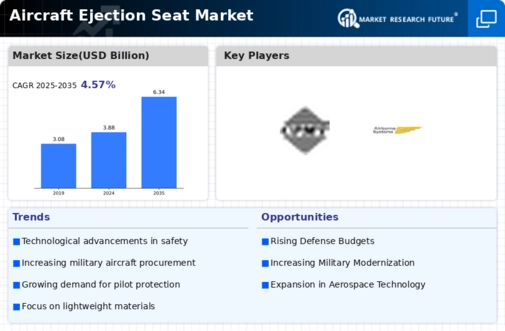Market Share
Aircraft Ejection Seat Market Share Analysis
The Aircraft Ejection Seat market is witnessing several trends that reflect the evolving landscape of aviation safety and technology. One notable trend is the increasing integration of smart and connected features within ejection seat systems. Advanced sensors, data analytics, and communication capabilities are being incorporated to enhance the overall situational awareness of pilots during emergency ejections. These smart features provide real-time data on the pilot's status, environmental conditions, and the ejection process itself, contributing to more precise and effective ejection scenarios.
Another significant trend is the focus on lightweight materials and design optimization in ejection seat development. Manufacturers are increasingly exploring materials that offer high strength-to-weight ratios, ensuring that ejection seats are not only robust and reliable but also contribute to the overall weight reduction of modern aircraft. This trend aligns with the aviation industry's emphasis on fuel efficiency and performance, driving the adoption of innovative materials and design methodologies in ejection seat manufacturing.
Enhanced survivability is a key trend in the Aircraft Ejection Seat market, with a focus on improving the chances of pilot survival in a broader range of emergency scenarios. Manufacturers are incorporating technologies such as advanced parachute systems, automatic activation devices, and enhanced life support features to maximize the safety outcomes for ejected pilots. This trend underscores the continuous commitment to refining ejection seat capabilities and addressing a wider spectrum of potential emergency situations.
Human factors and ergonomics are gaining prominence as essential considerations in ejection seat design trends. The goal is to optimize the ejection experience for pilots of varying physical attributes, accommodating a diverse demographic within air forces and aviation operations. Customizable and adjustable features, along with considerations for pilot comfort and safety, are becoming integral aspects of the evolving trends in ejection seat design to ensure that these critical safety systems can effectively accommodate a diverse pilot population.
The integration of advanced escape systems is a noteworthy trend, with a focus on expanding the operational envelope for ejection seats. Manufacturers are working on systems that can cater to a broader range of altitudes, airspeeds, and aircraft configurations, ensuring that ejection remains a viable option across diverse mission profiles. This trend aligns with the versatility required in modern military aviation, where aircraft are designed for multifaceted roles and operations.
International collaborations and partnerships are emerging trends in the Aircraft Ejection Seat market, reflecting a globalized approach to safety and technology development. Manufacturers are increasingly engaging in joint ventures, research initiatives, and technology-sharing agreements to pool resources and expertise. This collaborative trend fosters cross-border innovation, standardization, and the development of ejection seat solutions that can meet the varied requirements of different nations and aviation platforms.
The use of simulation technologies for ejection seat training is gaining traction as a market trend. Training programs involving realistic ejection scenarios contribute to pilot preparedness and safety. Manufacturers are incorporating advanced simulation capabilities to replicate the complex dynamics of ejection, allowing pilots to undergo training in a controlled environment. This trend reflects a commitment to enhancing pilot proficiency and ensuring that they are well-prepared for emergency situations.
A growing emphasis on sustainability and environmental considerations is influencing trends in ejection seat manufacturing. Manufacturers are exploring eco-friendly materials and manufacturing processes to align with broader industry goals of reducing environmental impact. This trend reflects a recognition of the importance of sustainability in aviation, even within specialized components like ejection seats.
The customization of ejection seat solutions for specific aircraft platforms is a prevalent trend in the market. As aircraft designs become more diverse and mission-specific, manufacturers are tailoring ejection seat systems to meet the unique requirements of different aircraft models. This trend ensures that ejection seats are optimally integrated into various platforms, considering factors such as cockpit layout, aircraft weight distribution, and mission profiles.






Leave a Comment